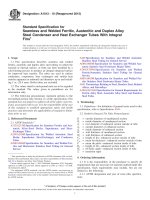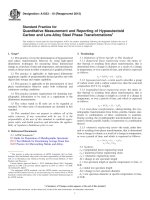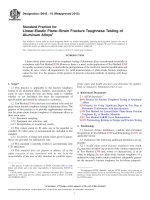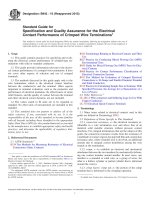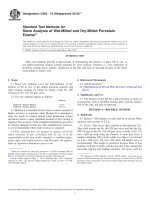Astm e 2005 10 (2015)
Bạn đang xem bản rút gọn của tài liệu. Xem và tải ngay bản đầy đủ của tài liệu tại đây (121.72 KB, 6 trang )
Designation: E2005 − 10 (Reapproved 2015)
Standard Guide for
Benchmark Testing of Reactor Dosimetry in Standard and
Reference Neutron Fields1
This standard is issued under the fixed designation E2005; the number immediately following the designation indicates the year of
original adoption or, in the case of revision, the year of last revision. A number in parentheses indicates the year of last reapproval. A
superscript epsilon (´) indicates an editorial change since the last revision or reapproval.
simeters (Withdrawn 2002)3
E393 Test Method for Measuring Reaction Rates by Analysis of Barium-140 From Fission Dosimeters
E482 Guide for Application of Neutron Transport Methods
for Reactor Vessel Surveillance, E706 (IID)
E523 Test Method for Measuring Fast-Neutron Reaction
Rates by Radioactivation of Copper
E526 Test Method for Measuring Fast-Neutron Reaction
Rates by Radioactivation of Titanium
E704 Test Method for Measuring Reaction Rates by Radioactivation of Uranium-238
E705 Test Method for Measuring Reaction Rates by Radioactivation of Neptunium-237
E854 Test Method for Application and Analysis of Solid
State Track Recorder (SSTR) Monitors for Reactor
Surveillance, E706(IIIB)
E910 Test Method for Application and Analysis of Helium
Accumulation Fluence Monitors for Reactor Vessel
Surveillance, E706 (IIIC)
E1297 Test Method for Measuring Fast-Neutron Reaction
Rates by Radioactivation of Niobium
E2006 Guide for Benchmark Testing of Light Water Reactor
Calculations
1. Scope
1.1 This guide covers facilities and procedures for benchmarking neutron measurements and calculations. Particular
sections of the guide discuss: the use of well-characterized
benchmark neutron fields to calibrate integral neutron sensors;
the use of certified-neutron-fluence standards to calibrate
radiometric counting equipment or to determine interlaboratory
measurement consistency; development of special benchmark
fields to test neutron transport calculations; use of well-known
fission spectra to benchmark spectrum-averaged cross sections;
and the use of benchmarked data and calculations to determine
the uncertainties in derived neutron dosimetry results.
1.2 The values stated in SI units are to be regarded as
standard. No other units of measurement are included in this
standard.
2. Referenced Documents
2.1 ASTM Standards:2
E170 Terminology Relating to Radiation Measurements and
Dosimetry
E261 Practice for Determining Neutron Fluence, Fluence
Rate, and Spectra by Radioactivation Techniques
E263 Test Method for Measuring Fast-Neutron Reaction
Rates by Radioactivation of Iron
E264 Test Method for Measuring Fast-Neutron Reaction
Rates by Radioactivation of Nickel
E265 Test Method for Measuring Reaction Rates and FastNeutron Fluences by Radioactivation of Sulfur-32
E266 Test Method for Measuring Fast-Neutron Reaction
Rates by Radioactivation of Aluminum
E343 Test Method for Measuring Reaction Rates by Analysis of Molybdenum-99 Radioactivity From Fission Do-
3. Significance and Use
3.1 This guide describes approaches for using neutron fields
with well known characteristics to perform calibrations of
neutron sensors, to intercompare different methods of
dosimetry, and to corroborate procedures used to derive neutron field information from measurements of neutron sensor
response.
3.2 This guide discusses only selected standard and reference neutron fields which are appropriate for benchmark
testing of light-water reactor dosimetry. The Standard Fields
considered are neutron source environments that closely approximate the unscattered neutron spectra from 252Cf spontaneous fission and 235U thermal neutron induced fission. These
standard fields were chosen for their spectral similarity to the
1
This guide is under the jurisdiction of ASTM Committee E10 on Nuclear
Technology and Applications and is the direct responsibility of Subcommittee
E10.05 on Nuclear Radiation Metrology.
Current edition approved Oct. 1, 2015. Published November 2015. Originally
approved in 1999. Last previous edition approved in 2010 as E2005 - 10. DOI:
10.1520/E2005-10R15.
2
For referenced ASTM standards, visit the ASTM website, www.astm.org, or
contact ASTM Customer Service at For Annual Book of ASTM
Standards volume information, refer to the standard’s Document Summary page on
the ASTM website.
3
The last approved version of this historical standard is referenced on
www.astm.org.
Copyright © ASTM International, 100 Barr Harbor Drive, PO Box C700, West Conshohocken, PA 19428-2959. United States
1
E2005 − 10 (2015)
ated uncertainties for the NIST 252Cf irradiation facility are
discussed in Ref (4). The principal uncertainties, which only
total about 2.5 %, come from the source strength
determination, scattering corrections, and distance measurements. Extensive details of standard field characteristics and
values of measured and calculated spectrum-averaged cross
sections are all given in a compendium, see Ref (5).
5.2.2 The NIST 252Cf sources have a very nearly unperturbed spontaneous fission spectrum, because of the lightweight encapsulations, fabricated at the Oak Ridge National
Laboratory (ORNL), see Ref (6).
5.2.3 For a comprehensive view of the calibration and use of
a special (32 mg) 252Cf source employed to measure the
spectrum-averaged cross section of the 93Nb(n,n') reaction, see
Ref (7).
high energy region (E > 2 MeV) of reactor spectra. The various
categories of benchmark fields are defined in Terminology
E170.
3.3 There are other well known neutron fields that have
been designed to mockup special environments, such as
pressure vessel mockups in which it is possible to make
dosimetry measurements inside of the steel volume of the
“vessel.” When such mockups are suitably characterized they
are also referred to as benchmark fields. A variety of these
engineering benchmark fields have been developed, or pressed
into service, to improve the accuracy of neutron dosimetry
measurement techniques. These special benchmark experiments are discussed in Guide E2006, and in Refs (1)4 and (2).
4. Neutron Field Benchmarking
5.3 235U Fission Spectrum—Standard Neutron Field:
5.3.1 Because 235U fission is the principal source of neutrons in present nuclear reactors, the 235U fission spectrum is a
fundamental neutron field for benchmark referencing or dosimetry accomplished in reactor environments. This remains
true even for low-enrichment cores which have up to 30 %
burnup.
5.3.2 There are currently two 235U standard fission spectrum
facilities, one in the thermal column of the NIST Research
Reactor (8) and one at CEN/SCK, Mol, Belgium (9).
5.3.3 A standard 235U neutron field is obtained by driving
(fissioning) 235U in a field of thermal neutrons. Therefore, the
fluence rate depends upon the power level of the driving
reactor, which is frequently not well known or particularly
stable. Time dependent fluence rate, or total fluence, monitoring is necessary in the 235U field. Certified fluence irradiations
are monitored with the 58Ni(n,p)58Co activation reaction. The
fluence-monitor calibration must be benchmarked.
5.3.4 For 235U, as for 252Cf irradiations, small (nominally
< 3 %) scattering and absorption corrections are necessary. In
addition, for 235U, gradient corrections of the measured fluence
which do not simply depend upon distance are necessary. The
scattering and gradient corrections are determined by Monte
Carlo calculations. Field characteristics of the NIST 235U
Fission Spectrum Facility and associated measured and calculated cross sections are given in Ref (5).
4.1 To accomplish neutron field “benchmarking,” one must
perform irradiations in a well-characterized neutron
environment, with the required level of accuracy established by
a sufficient quantity and quality of results supported by a
rigorous uncertainty analysis. What constitutes sufficient results and their required accuracy level frequently depends upon
the situation. For example:
4.1.1 Benchmarking to test the capabilities of a new dosimeter;
4.1.2 Benchmarking to ensure long-term stability, or
continuity, of procedures that are influenced by changes of
personnel and equipment;
4.1.3 Benchmarking measurements that will serve as the
basis of intercomparison of results from different laboratories;
4.1.4 Benchmarking to determine the accuracy of newly
established benchmark fields; and
4.1.5 Benchmarking to validate certain ASTM standard
methods or practices which derive exposure parameters (for
example, fluence > 1 MeV or dpa) from dosimetry measurements and calculations.
5. Description of Standard and Reference Fields
5.1 There are a few facilities which can provide certified
“free field” fluence irradiations. The following provides a list
of such facilities. The emphasis is on facilities that have a
long-lived commitment to development, maintenance,
research, and international interlaboratory comparison calibrations. As such, discussion is limited to recently existing
facilities.
5.4 There are several additional facilities that can provide
free field fluence irradiations that qualify as reference fields.
The following is a list of some of the facilities that have
characterized reference fields:
5.4.1 Annular Core Research Reactor (ACRR) Central Cavity – Reference Neutron Field (10,11),
5.4.2 ACRR Lead-Boron Cavity Insert – Reference Neutron
Field (11),
5.4.3 YAYOI fast neutron field – Reference Neutron Field
(12,13),
5.4.4 SIGMA-SIGMA neutron field – Reference Neutron
Field (12,13).
5.2 252Cf Fission Spectrum—Standard Neutron Field:
5.2.1 The standard fission-spectrum fluence from a suitably
encapsulated 252Cf source is characterized by its source
strength, the distance from the source, and the irradiation time.
In the U.S., neutron source emission rate calibrations are all
referenced to source calibrations at the National Institute of
Standards and Technology (NIST) accomplished by the
MnSO4 technique (3). Corrections for neutron absorption,
scattering, and other than point-geometry conditions may, by
careful experimental design, be held to less than 3 %. Associ-
6. Applications of Benchmark Fields
6.1 Notation—Reaction Rate, Fluence Rate, and Fluence—
The notation employed in this section will follow that in E261
(Standard Practice for Determining Neutron Fluence Rate, and
4
The boldface numbers given in parentheses refer to a list of references at the
end of the text.
2
E2005 − 10 (2015)
Further, consider a dosimeter pair irradiated in compensated
beam geometry (with each member of the pair equidistant
from, and on opposite sides of, the 252Cf source). For such an
irradiation in a large room (where very little room return
occurs), the fluence rate – with a 252Cf fission spectrum – is
known to within 63 % from the source strength, and the
average distance of the dosimeter pair from the center of the
source. Questions concerning in- and out-scattering by source
encapsulation, source and foil holders, and foil thicknesses
may be accurately investigated by Monte Carlo calculations.
There is no other neutron-irradiation situation that can approach this level of accuracy in determination of the fluence or
fluence rate.
6.2.2 Fluence Transfer Calibrations of Reference Fields—
The benefit of irradiating with a source of known emission rate
is lost when one must consider reactor cores or, even, thermalneutron fissioned 235U sources. When the latter are carefully
constructed to provide for an unmoderated 235U spectrum, this
mentioned disadvantage can be circumvented by a process
called fluence transfer. As explained briefly in 6.2, this process
is basically as follows. A gamma-counter (spectrometer) geometry is chosen to enable proper counting of the activities of
a particular isotopic reaction for example, 58Ni(n,p)58Co, after
irradiation in either a 252Cf or 235U field. Then the 252Cf
irradiation is accomplished and the nickel foil counted. From
this, a ratio of the dosimeter response divided by the 252Cf
certified fluence is determined. Subsequently, an identical
nickel is irradiated in the 235U spectrum and that foil is counted
with the same counter geometry. Within the knowledge of the
ratio of the spectrum average cross sections in the two spectra,
knowledge of the counter response to the recent irradiation
yields the average 235U fluence. Note, the average fluence is
measured. The thermal fluence rate at the 235U sources may not
have been constant over the time of the irradiation but that time
is assumed to be short relative to the 70 day half-life of the
58
Co, which monitors the fast neutron fluence through-out the
irradiation. The method of calibration is termed fluence rate
transfer because it is fluence rate which is determined, and
there is no need to determine the absolute radioactivity of the
dosimeters. Relative response of the same counter geometry is
the only requirement.
6.2.3 Reactor Irradiations—In principle, the same fluencetransfer procedures can be applied to more complex irradiations. However, there are certain other situations which must
be considered and weighed to determine if fluence transfer or
reaction rate determination is the better method. Also remember that error estimation can be examined by using both
methods.
6.2.3.1 If radioactivation dosimeters are employed for long
term irradiations in a power reactor, the fluence at a dosimeter
location can be determined by the method explained in 9.7,
Long Term Irradiations, of Practice E261, taking into account
the relative power level changes over the course of the
irradiation. There may be practical problems, however. In
particular, if the measured activity does not have a sufficiently
long half-life, it can not provide a correct measure of the
fluence. Said another way, if the dosimeter exposure time is
more than about 3.5 times the half-life of the radioactive
Spectra by Radioactivation Techniques) except as noted. The
reaction rate, R, for some neutron-nuclear reaction {reactions/
[(dosimeter target nucleus)(second)]} is given by:
R5
*
`
o
σ ~ E ! φ ~ E ! dE
(1)
or:
R 5 σ¯ φ
(2)
where:
σ(E) = the dosimeter reaction cross section at energy E
(typically of the order of 10–24 cm2),
φ(E) = the differential neutron fluence rate, that is the
fluence per unit time and unit energy for neutrons
with
energies between E and E + dE (neutrons
–2
cm s–1 MeV–1),
φ
= the total fluence rate (neutrons cm–2s–1), the integral
of φ(E) over all E, and
σ¯
= the spectral-averaged value of σ(E), R/φ.
NOTE 1—Neutron fluence and fluence rate are defined formally in
Terminology E170 under the listing “particle fluence.” Fluence is just the
time integral of the fluence rate over the time interval of interest. The
fluence rate is also called the flux or flux density in many papers and books
on neutron transport theory.
6.1.1 The reaction rate is found experimentally using an
active instrument such as a fission chamber (see Ref (14)) or a
passive dosimeter such as a solid state track recorder (see Test
Method E854), a helium accumulation fluence monitor (see
Test Method E910), or a radioactivation dosimeter (see Practice E261). For the radioactivation method, there are also
separate standards for many particularly important dosimetry
nuclides, for example, see Test Methods E263, E264, E265,
E266, E343, E393, E523, E526, E704, E705, and E1297.
6.2 Fluence Rate Transfer: Note that if one determines φ =
R/σ¯ from Eq 2, then the uncertainty in φ will be a propagation
of the uncertainties in both R and σ¯ . The uncertainty in σ¯ is
frequently large, leading to a less accurate determination of φ
than desired. However, if one can make an additional irradiation of the same type of dosimeter in a standard neutron field
with known fluence rate, then one may apply Eq 2 to both
irradiations and write
φ A 5 φ B ~ R A /R B ! ~ σ¯ B /σ¯ A !
(3)
where “A” denotes the field of interest and “B” denotes the
standard neutron field benchmark. In Eq 3 the ratios of spectral
average cross section, will have a small uncertainty if the
spectral shapes φA (E) and φB (E) are fairly similar. There may
also be important cancellation of poorly known factors in the
ratio RA/RB, which will contribute to the better accuracy of Eq
3. Whether φ is better determined by Eq 3 or Eq 2 must be
evaluated on a case by case basis. Often the fluence rate from
Eq 3 is substantially more accurate and provides a very useful
validation of other dosimetry. The use of a benchmark neutron
field irradiation and Eq 3 is called fluence rate transfer.
6.2.1 Certified Fluence or Fluence Rate Irradiations—The
primary benefit from carefully-made irradiations in a standard
neutron field is that of knowing the neutron fluence rate.
Consider the case of a lightly encapsulated 252Cf sinteredoxide bead, which has an emission rate known to about
61.5 % by calibration in a manganese bath (MnSO4 solution).
3
E2005 − 10 (2015)
inelastic scattering cross section data) in calculations of neutron transport through reactor pressure vessels and related
benchmark or reference neutron fields (15). Similarly if the
transport cross section data is considered to be well known for
some case of interest, the Ca/b ratio may be taken as a test of the
transport calculation method itself or of other input data to
which the spectrum is sensitive.
isotopic activity, the dosimeter does not “remember” the early
part of the irradiation history.
6.2.3.2 Another problem is that of the available isotopic
reactions that monitor fast neutron fluence, only two have
sufficiently long half-lives and respond over a reasonable
energy range (1 MeV to 6 MeV) to monitor multi-year
power-reactor irradiation cycles. They are the 137Cs fission
product (from the 238 U(n,f) or 237Np(n,f) reactions) or the
93
Nb(n,n') with its 93mNb 16 year half-life. In both cases, it is
essential that some benchmarking to a reference neutron field
be accomplished to insure that the radioactive products are
being adequately determined for use in Eq (6). A brief
explanation of cesium and niobium counting follows:
6.2.3.3 Determining the Activity of 137Cs in a Background
of Other Fission Products—The standard test methods for
analysis of radioactivation of 238U and 237Np dosimeters are
described in the Test Methods E704 and E705. However, for
about three years after 238U or 237Np are irradiated, the
signal-to-background ratio (or the ratio of the net area under
the 661.7 keV photopeak of 137Cs to the background) is rather
low, varying from a value of near 1.0 to about 3.5.
Furthermore, there are various interference peaks of timedependent intensity in the background spectra, both above and
below the photopeak. For 237Np dosimeters, the inherent 233Pa
gamma background is an additional difficulty. For these
reasons, it is advisable to validate 137Cs fission product
counting by use of a certified fluence irradiation in a suitable
reference neutron field.
6.2.3.4 Determining the Activity of 93mNb—The 93Nb(n,n')
93m
Nb reaction as a fast-neutron dosimeter also presents some
special problems. The products to be counted are X-rays. These
same X-rays may be fluoresced by tantalum impurities in the
niobium dosimeter. Test Method E1297 describes the standard
test method and its limitations. Validation by a reference
neutron field irradiation is advisable because of the unusual
techniques required in the measurement of radioactivation for
this nuclide.
8. Precision and Bias
NOTE 2—Measurement uncertainty is described by a precision and bias
statement in this practice. Another acceptable approach is to use Type A
and B uncertainty components (see ISO Guide in the Expression of
Uncertainty in Measurement and Ref (16)). This Type A/B uncertainty
specification is now used in International Organization for Standardization
(ISO) standards, and this approach can be expected to play a more
prominent role in future uncertainty analyses.
8.1 The information content of uncertainty statements
determines, to a large extent, the value of the effort. A common
deficiency in many statements of uncertainty is that they do not
convey all the pertinent information. One pitfall is over
simplification, for example, the practice of obliterating all the
identifiable components of the uncertainty, by combining them
into an overall uncertainty, just for the sake of simplicity.
8.2 Error propagation with integral detectors is complex
because such detectors do not measure neutron fluence directly,
and because the same measured detector responses from which
a neutron fluence is derived are also used to help establish the
neutron spectrum required for that fluence derivation.
8.3 Many “measured” dosimetry results are actually derived
quantities because the observed raw data must be corrected, by
a series of multiplicative correction factors, to compensate for
other than ideal circumstances during the measurement. It is
not always clear after data corrections have been made and
averages taken just how the uncertainties were taken into
account. Therefore, special attention should be given to discussion of uncertainty contributions when they are comparable
to or larger than the normally considered statistical uncertainties. Furthermore, benchmark procedures owe their effectiveness to strong correlations which can exist between the
measurements in the benchmark and study fields. Other correlations can also exist among the measurements in each of those
types of fields. It is, therefore, vital to identify those uncertainties which are correlated, between fields, among
measurements, and in some cases where it may be ambiguous,
those uncertainties which are uncorrelated. For example, differential cross section data and multigroup neutron spectra are
generally assumed to be uncorrelated. However, when a
spectrum is used to derive new spectrum-averaged cross
sections for a new multigroup structure with considerably
fewer groups, the new multigroup cross sections and multigroup spectrum are not uncorrelated.
7. Spectral Indexes
7.1 A spectral index, Sa/b = Ra/Rb, is the ratio of the reaction
rates of two isotopes in the same neutron field. Usually these
are chosen to be isotopes with markedly different spectral
response, that is, significantly different threshold energies and
median response energies. In any designated spectrum where
the “a” and “b” dosimeters see the same φ, this ratio is identical
to the ratio of their spectrum-averaged cross sections. The
double ratio, Ca/b, of the calculated spectral index, Scal, to the
measured index, Smeas, is often one of the most accurate
experimental tests of the calculated neutron energy spectrum:
C a/b 5 ~ S a/b ! cal/ ~ S a/b ! meas
(4)
7.2 The same reaction cross section data employed in the
calculation should be employed in deriving the experimental
reaction rates. Then the uncertainty in the double ratio Ca/b
tends to be low, because of cancellation of reaction cross
section biases and some experimental biases, such as the
efficiency biases in the reaction counting apparatus. The
departure of the double ratio Ca/b from unity may be used as a
validation test of transport cross section data (especially iron
8.4 Precautions to Help Reduce Uncertainties in Measurements:
8.4.1 The spectral differences between the benchmark and
study fields may lead to significantly different response from
impurities in the dosimeters. For example, 0.03 % 235U in a
238
U dosimeter or 0.012 % 239Pu impurity in a 237Np
dosimeter, will produce less than 1 % of the response in an
4
E2005 − 10 (2015)
9.2.2 Details of encapsulation or thermal-neutron shields
used.
9.2.3 Irradiation Loading Configurations—Several issues
are important here: positioning of individual dosimeters relative to fluence rate gradients; positioning relative to other
dosimeters and positioning or holding devices which may
perturb the fluence; and critical distances which relate to the
definition of fluence magnitudes.
9.2.4 Specification of the irradiation details with emphasis
on interruptions, power level changes, and consideration of
whether or not knowledge of absolute power level is important
for the interpretation of the dosimeters.
9.2.5 Specification of the procedures used to analyze the
dosimeters. In particular, attention should be given to possible
biases which frequently mask the reproducibility.
9.2.6 Details of the analysis of the dosimeters. These must
include details about equipment and methods calibrations. It
should also indicate where procedures or parameters may
create correlations among variables or results.
9.2.7 Final dosimetry results and associated uncertainties
including estimates of identifiable correlations.
9.2.8 Documentation about what benchmark referencing
has been done. Furthermore, when benchmark referencing has
influenced the calibration of instrumentation (for example, the
overall efficiency scale of a gamma counter), the documentation should explain what routine recalibration activities are
carried out to ensure that current operation is tied to the
benchmarking effort.
9.2.9 When benchmarking is accomplished relative to the
235
U fission spectrum, there should be documentation and
attention to consistent use of the specific form of the 235U
spectrum. This applies both to transport calculations and to
derivation of 235U fission spectrum averaged cross sections.
Neutron transport calculations for the analysis of reactor
surveillance should use a fission neutron source spectrum
which is consistent with the guidelines set forth in Guide E482.
unscattered fission-neutron field, but 5 to 10 % of the response
in a more thermalized reactor leakage spectrum.
8.4.2 There can be, and frequently are, unpredictable differences in dosimetry instrumentation for routine versus nonroutine measurements. This is more often true when the time
between calibration and use is either long or spans periods
when the equipment is moved, changed, or more than trivially
readjusted. A quality assurance program for a counting laboratory should include adequate and timely calibrations.
8.4.3 Frequently study fields require more and different
dosimeter encapsulations than those used in a standard field.
Such encapsulations lead to perturbations which can, in turn,
lead to significant systematic uncertainties.
8.4.4 Uncertainties associated with dosimeter positioning
are almost always larger at study fields because of less readily
available access to measurement locations. The radial location
of the in-vessel surveillance capsule is known in commercial
plants to about 6 0.6 cm, which corresponds to about 9 %
difference in the fast fluence rate.
8.4.5 Perturbations due to scattering effects in the immediate environment of the dosimeter are at least as significant in
the study field as they are in the standard field. However, they
are usually not as easy to investigate or to understand in the
study field.
8.4.6 Time limitations can be an underlying factor contributing to systematic uncertainties. In-the-field measurements
almost always suffer from lack of the thoroughness that
characterizes benchmark or calibration measurements.
9. Documentation
9.1 All facets of the experiments must be documented to
ensure that the overall results and related uncertainties, and
where possible correlations among parameters, accurately
reflect the conditions under which the measurements were
carried out. For example, the quality assurance requirements
for solid state track recorder (SSTR) dosimetry for reactor
surveillance are covered in detail in an appendix of Test
Method E854.
10. Keywords
10.1 activation dosimetry; benchmark neutron field;
certified-neutron-fluence standards; fluence-transfer; neutron
dosimetry; radiometric dosimetry; reference neutron field;
standard neutron field; uncertainties
9.2 As a minimum for benchmark experiments, documentation should include:
9.2.1 Information about the origin and purity of materials
used to fabricate the dosimetry.
REFERENCES
(1) NUREG/CR-3391, Vol 4, R5 “Compendium of Benchmark Neutron
Fields for Pressure Vessel Surveillance Dosimetry,” LWR Pressure
Vessel Surveillance Dosimetry Improvement Program, Quarterly
Progress Report October 1983 - December 1983.
(2) McElroy, W. N. and Karn, F.B.K., Eds., PSF Blind Test SSC, SPVC,
and SVBC Physics-Dosimetry-Metallurgy Data Packages, HEDL7449, Hanford Engineering Development Laboratory, Richland, WA,
February 1984.
(3) McGarry, E. D. and Boswell, E. W., Neutron Source Strength
Calibrations, NBS Special Publication 250-18, U.S. Department of
Commerce, National Institute of Standards and Technology, U.S.
Government Printing Office, Washington, DC, 1988.
(4) Lamaze G. P., and Grundl, J. A., Activation Foil Irradiation with
Californium Fission Sources, NBS Special Publication 250-13, U.S.
Department of Commerce, National Institute of Standards and
Technology, U.S. Government Printing Office, Washington, DC, 1988.
(5) Grundl J. A., and Eisenhauer, C. M., Compendium of Benchmark
Neutron Fields for Reactor Dosimetry, NBSIR 85-3151, National
Bureau of Standards, Gaithersburg, MD, January 1986.
(6) Williams, L. C., Bigelow, J. E., and Knauer, J. B., Jr., “Equipment and
Techniques for Remote Fabrication and Calibration of Physically
Small, High Intensity 252Cf Neutron Sources,” Proc. of 24th Conf. on
5
E2005 − 10 (2015)
Remote Systems Technology, 1976 , pp. 165-172.
(7) Williams, J. G., et al., “Measurements of Fission Spectrum Averaged
Cross Sections for the 93Nb(n,n')93mNb Reaction,” Reactor Dosimetry: Methods, Applications, and Standardization, STP-1001, Farrar/
Lippincott, Eds., May 1989.
(8) McGarry, E. D., Eisenhauer, C. M., Gilliam, D. M., J. Grundl, and G.
P. Lamaze, “The U.S. U-235 Fission Spectrum Standard Neutron
Field Revisited,” in Proceedings, Fifth ASTM-EURATOM Symposium
on Reactor Dosimetry, Geesthact, Germany, September 1984.
(9) Fabry, A., et al., “The MOL Cavity Fission Spectrum Standard
Neutron Field and Its Applications,” in Proc. of the 4th ASTMEuratom Symposium on Reactor Dosimetry, NUREG/CP-0029,
Nuclear Regulatory Commission, Washington, DC, July 1982.
(10) Griffin, P. J., Luker, S. M., Cooper, P. J., Vehar, D. W., DePriest, K.
R., and Holm, C. V., “Characterization of ACRR Reference Benchmark Field,” in Reactor Dosimetry in the 21st Century: Proceedings
of the 11th International Symposium on Reactor Dosimetry,
Wagemans/Abderrahim/D’hondt/De Raedt, Eds., June 2003.
(11) Williams, J. G., Griffin P. J., King, D. B., Vehar, D. W., Schnauber,
(12)
(13)
(14)
(15)
(16)
T., Luker, S. M., and DePriest, K. R., “Simultaneous Evaluation of
Neutron Spectra and 1-MeV-Equivalent (Si) Fluences at SPR-III and
ACRR, “IEEE Trans. on Nucl. Sci., Vol 54, No. 6 pp. 2296-2303,
December 2007.
INDC (SEC) - 54/L + DOS, IAEA Program on Benchmark Neutron
Fields Applications for Reactor Dosimetry, July 1976.
Neutron Cross Sections for Reactor Dosimetry , Vol 1, IAEA,
Vienna, p. 101, 1978.
Grundl, J. A., Gilliam, D. M., Dudey, N. D., and Popek, R. J.,
“Measurement of Absolute Fission Rates,” Nuclear Technology, 25,
1975.
Nico, J. S., Adams, J. M., Eisenhauer, C. M., Gilliam, D. M., and
Grundl, J. A., “ 252Cf Neutron Transport Through an Iron Sphere,”
Reactor Dosimetry, World Scientific Publishing, July 1997.
Taylor, B. N., and Kuyatt, C. E., Guideline for Evaluating and
Expressing the Uncertainty of NIST Measurement Results, NIST
Technical Note 1297, National Institute of Standards and
Technology, Gaithersburg, MD, 1994.
ASTM International takes no position respecting the validity of any patent rights asserted in connection with any item mentioned
in this standard. Users of this standard are expressly advised that determination of the validity of any such patent rights, and the risk
of infringement of such rights, are entirely their own responsibility.
This standard is subject to revision at any time by the responsible technical committee and must be reviewed every five years and
if not revised, either reapproved or withdrawn. Your comments are invited either for revision of this standard or for additional standards
and should be addressed to ASTM International Headquarters. Your comments will receive careful consideration at a meeting of the
responsible technical committee, which you may attend. If you feel that your comments have not received a fair hearing you should
make your views known to the ASTM Committee on Standards, at the address shown below.
This standard is copyrighted by ASTM International, 100 Barr Harbor Drive, PO Box C700, West Conshohocken, PA 19428-2959,
United States. Individual reprints (single or multiple copies) of this standard may be obtained by contacting ASTM at the above
address or at 610-832-9585 (phone), 610-832-9555 (fax), or (e-mail); or through the ASTM website
(www.astm.org). Permission rights to photocopy the standard may also be secured from the Copyright Clearance Center, 222
Rosewood Drive, Danvers, MA 01923, Tel: (978) 646-2600; />
6
